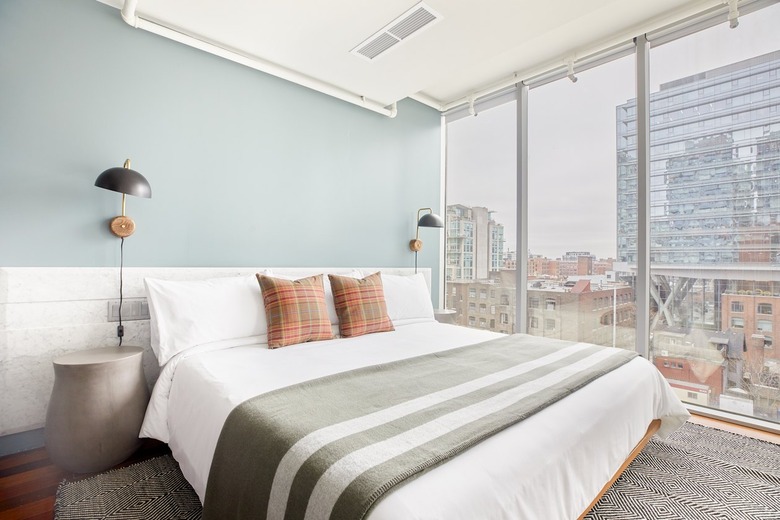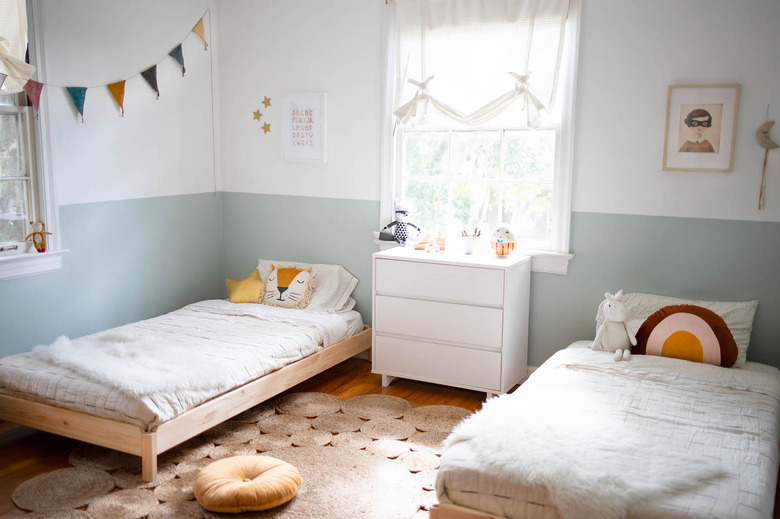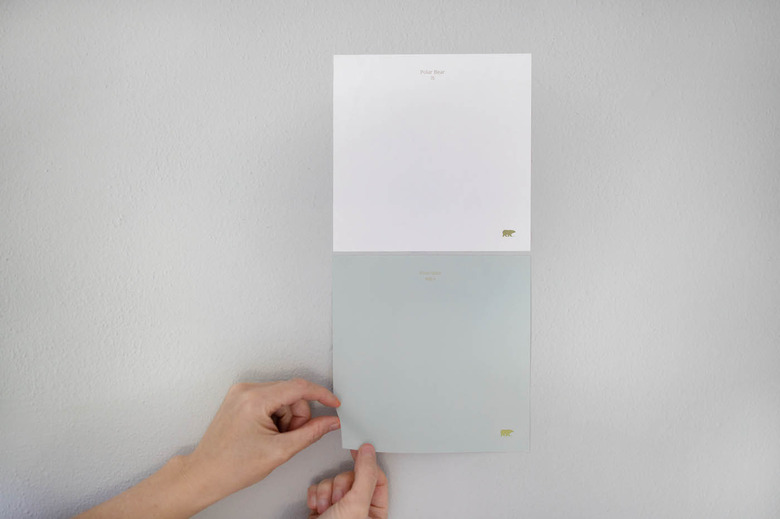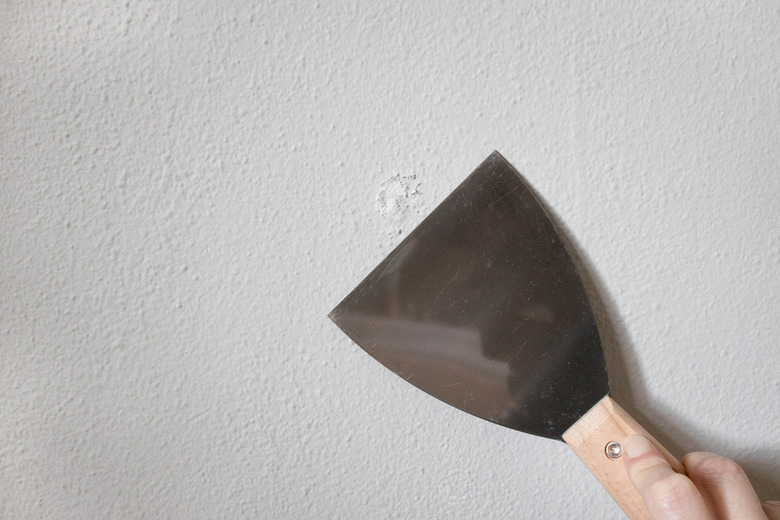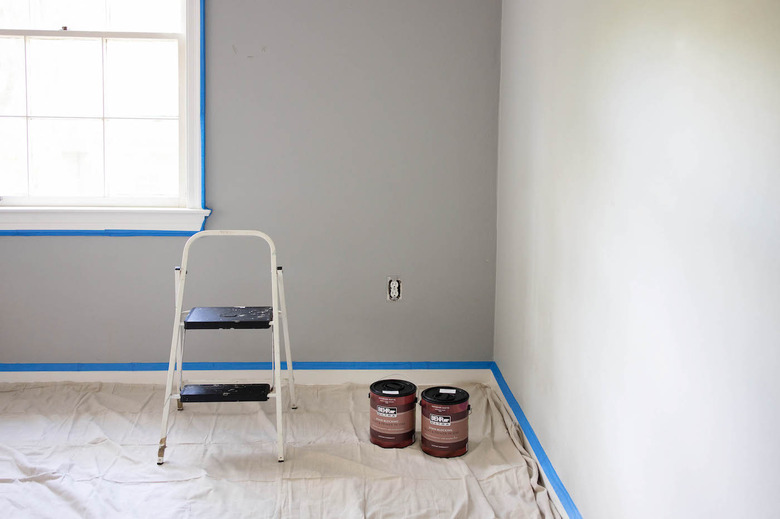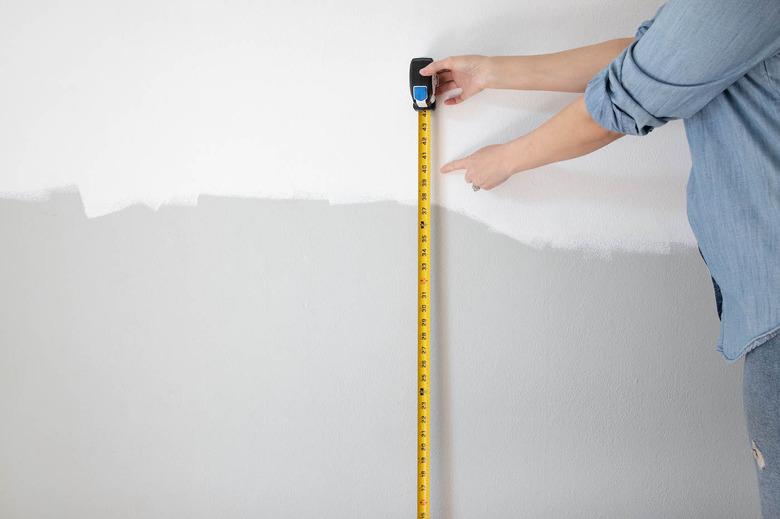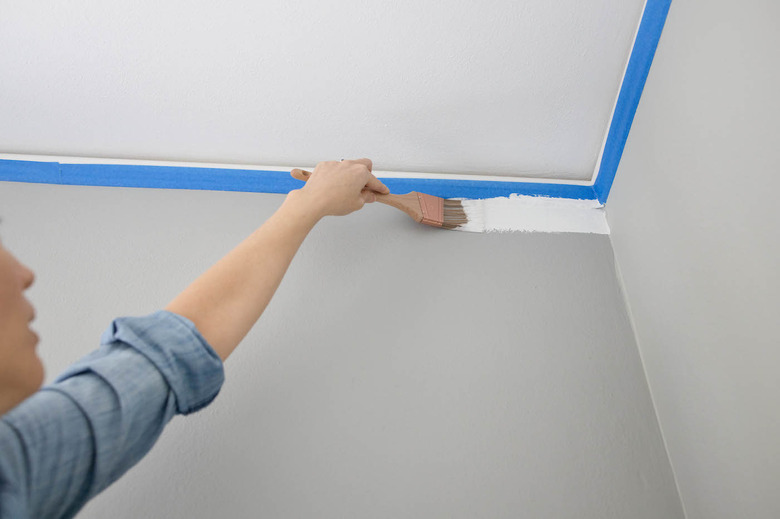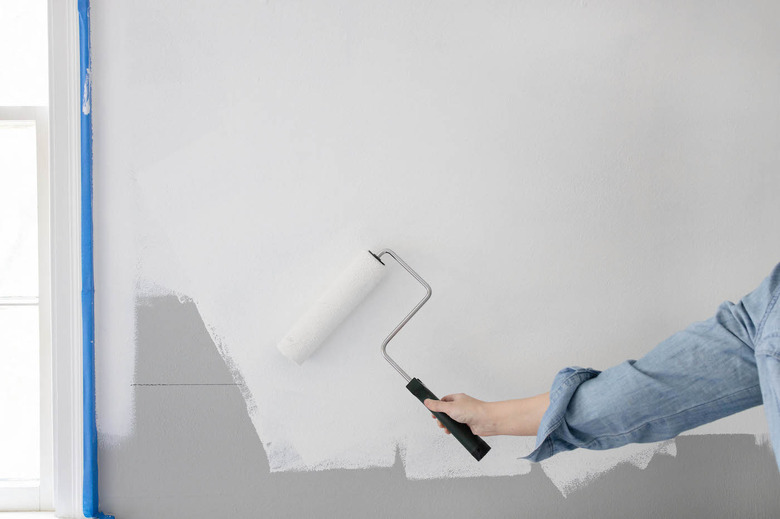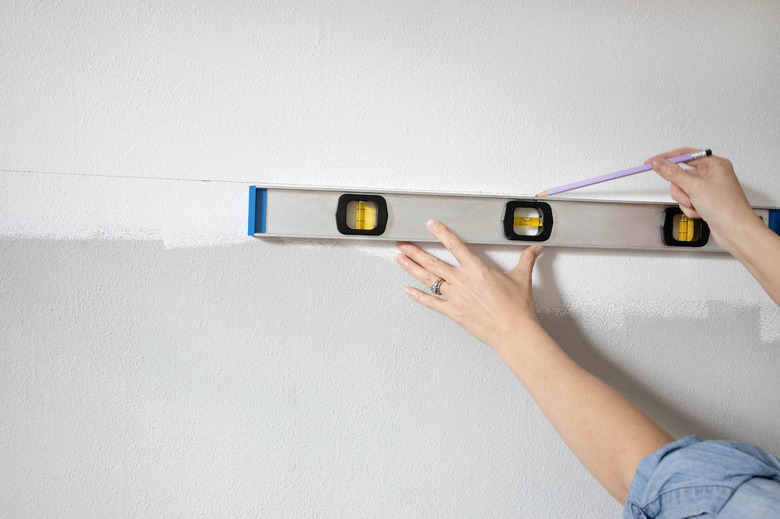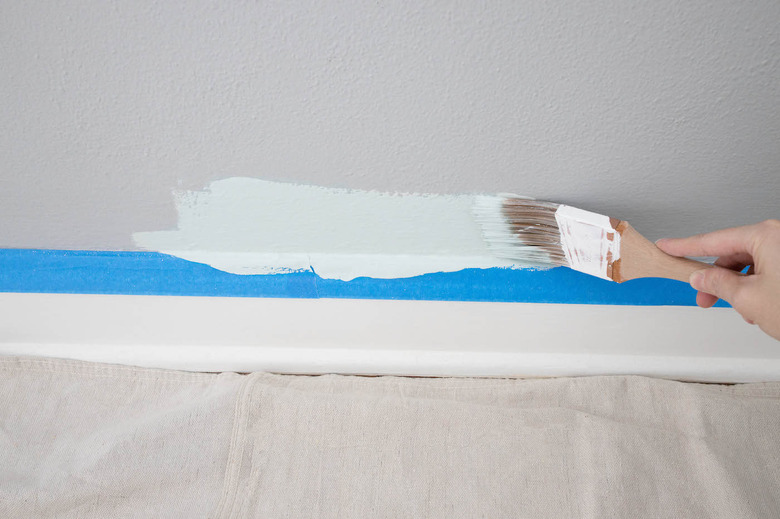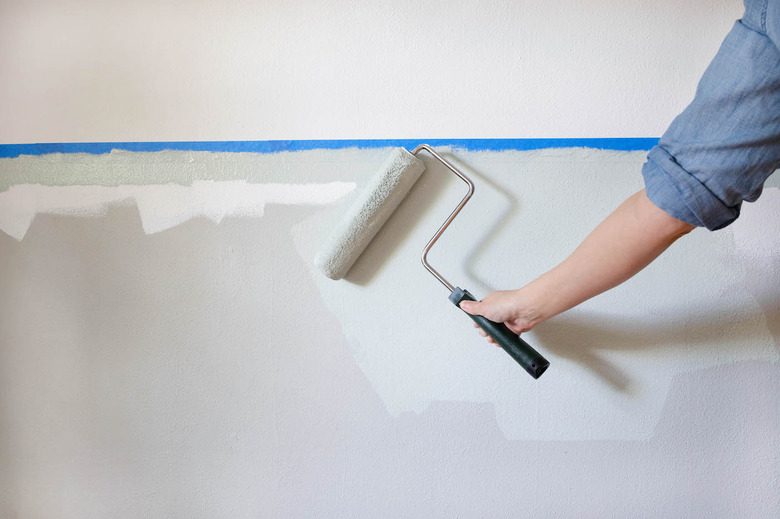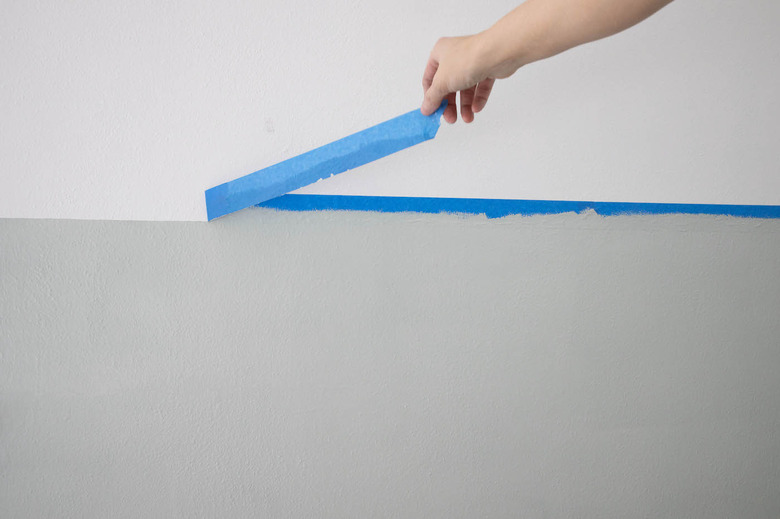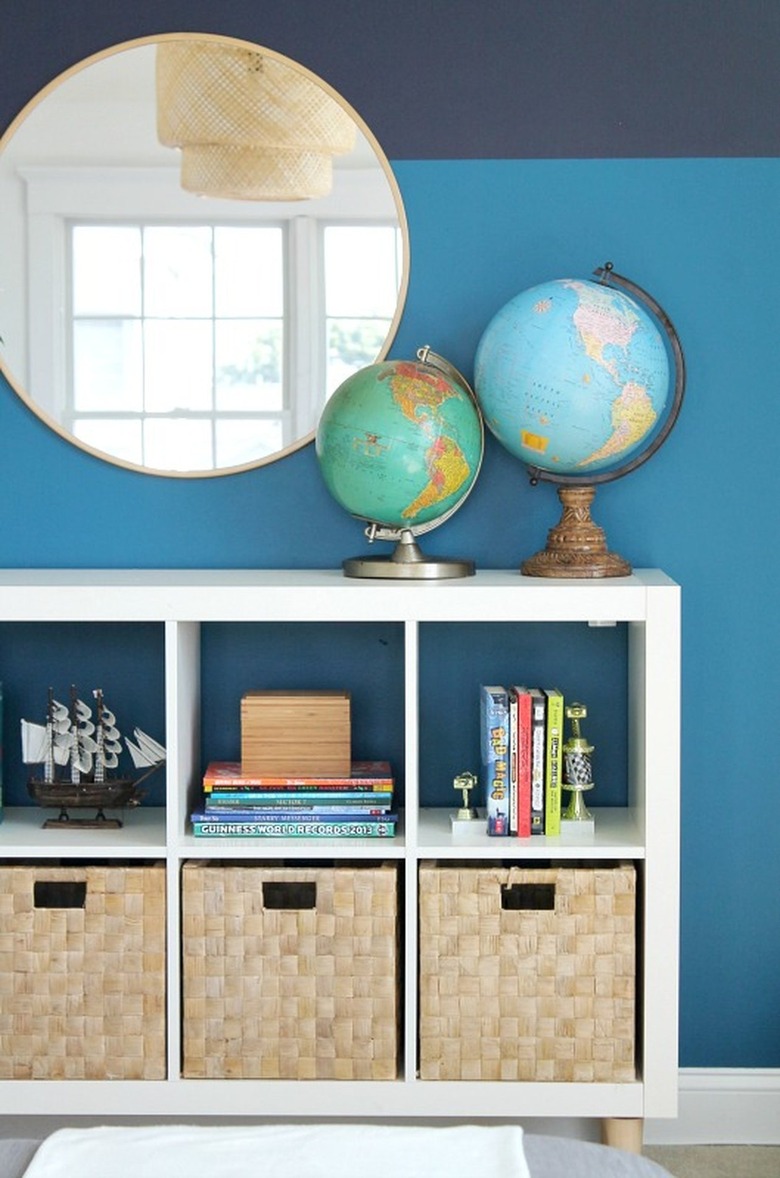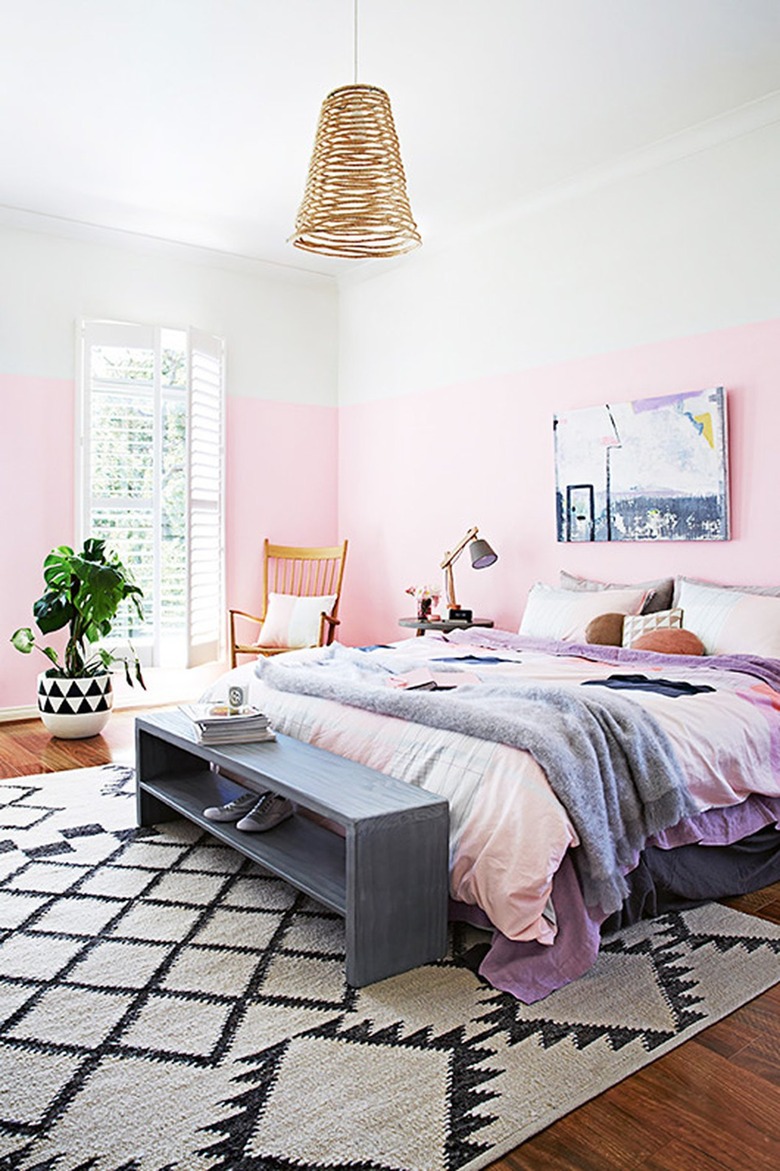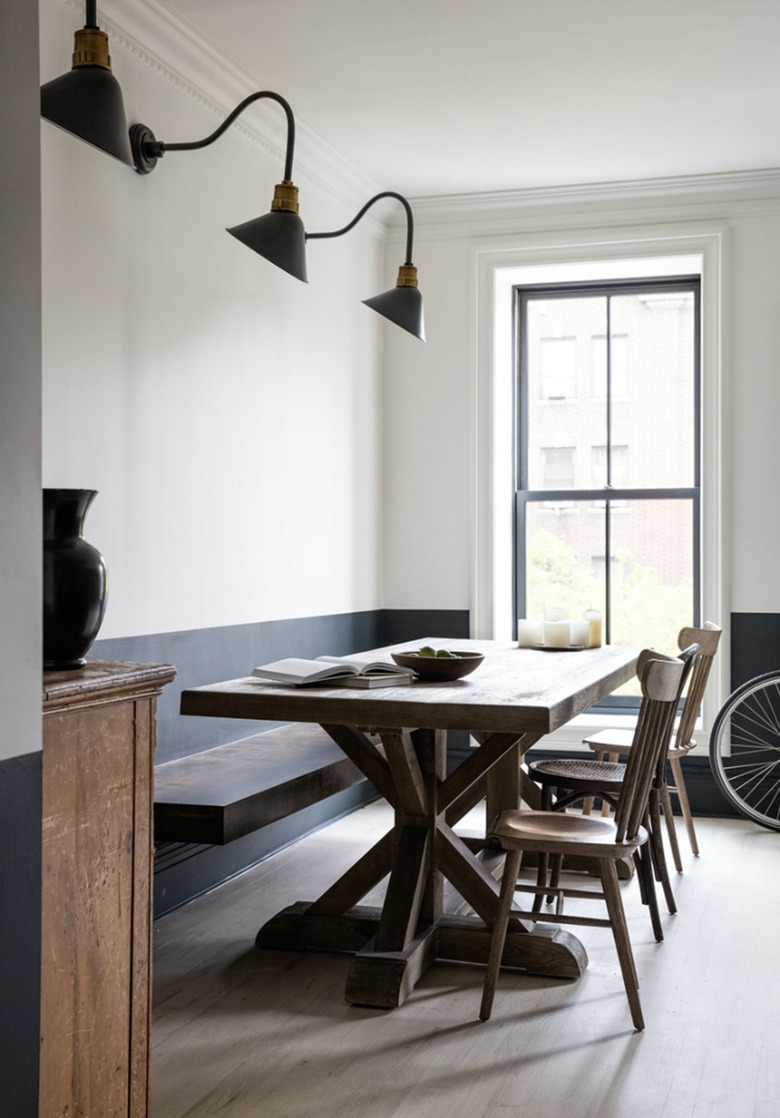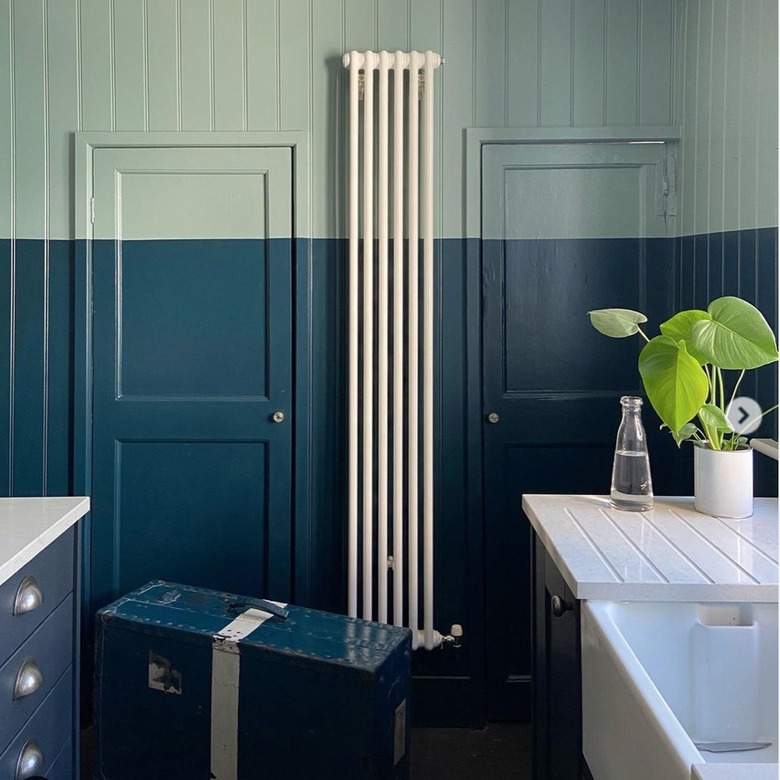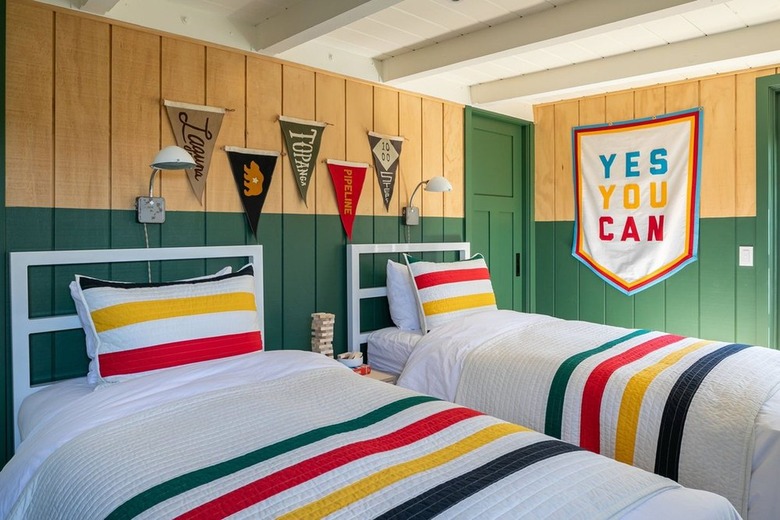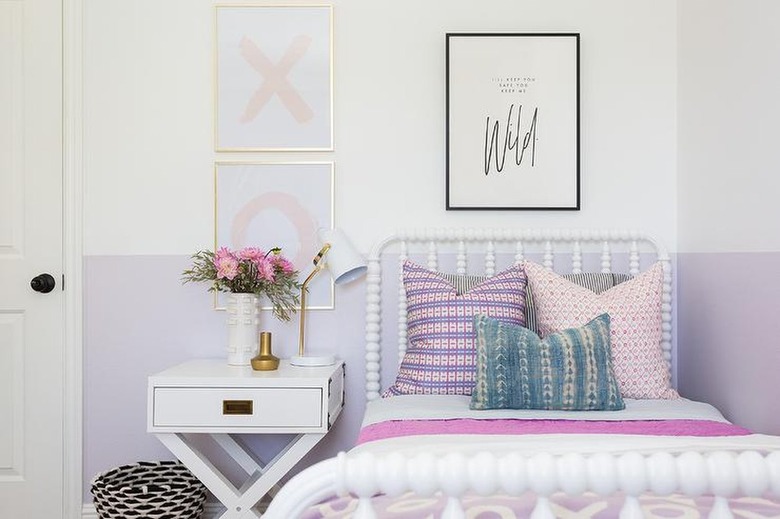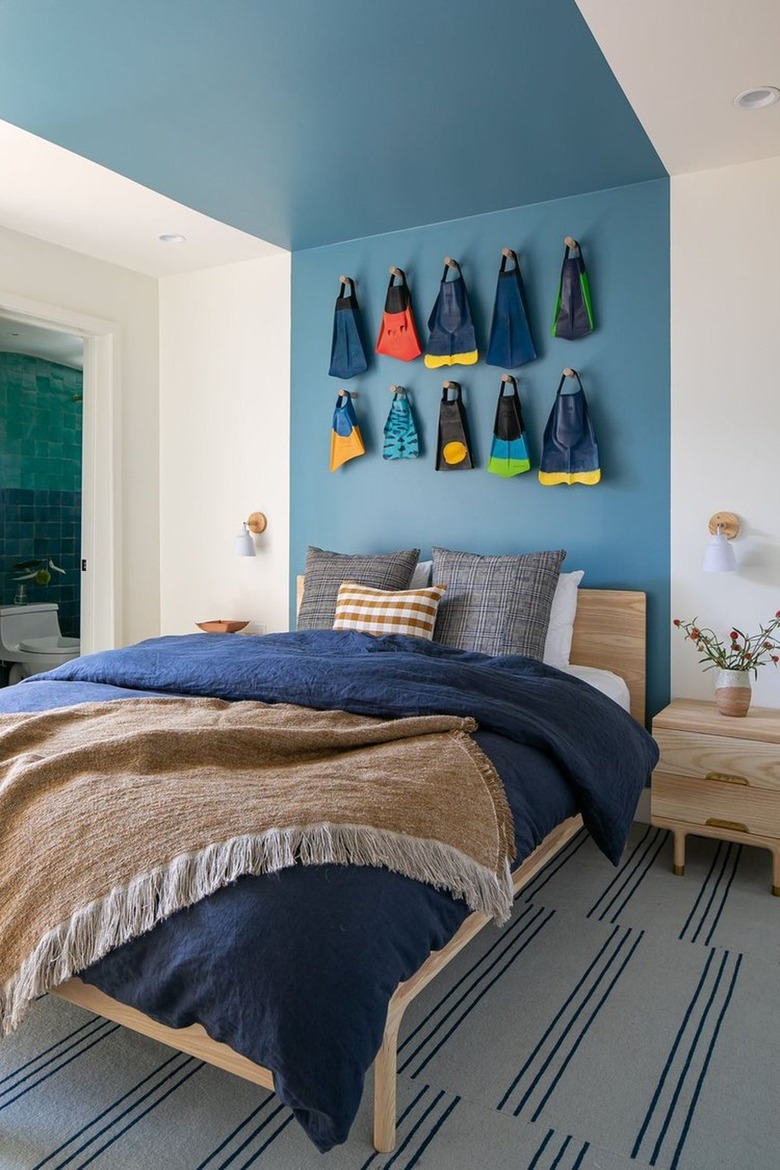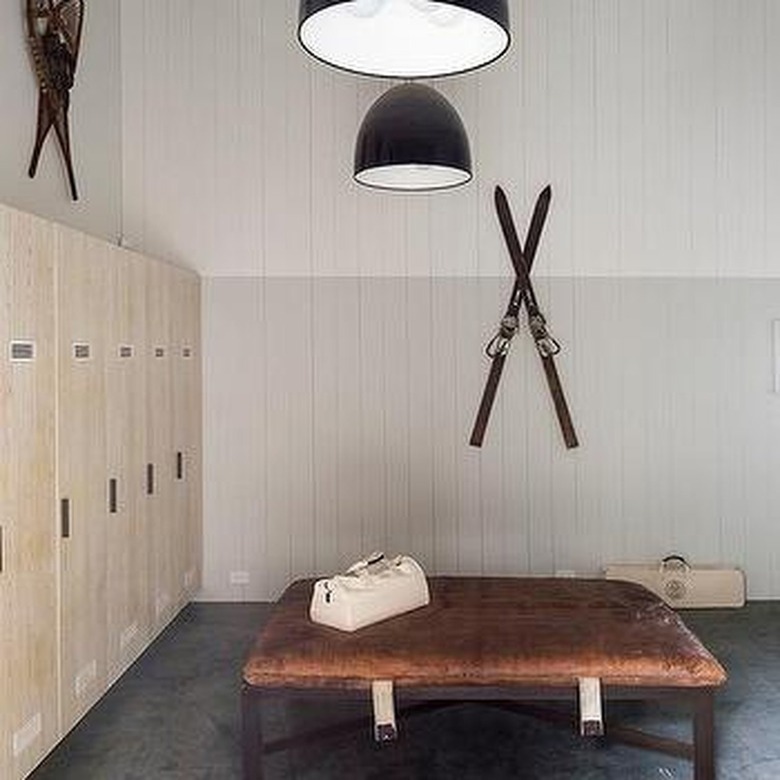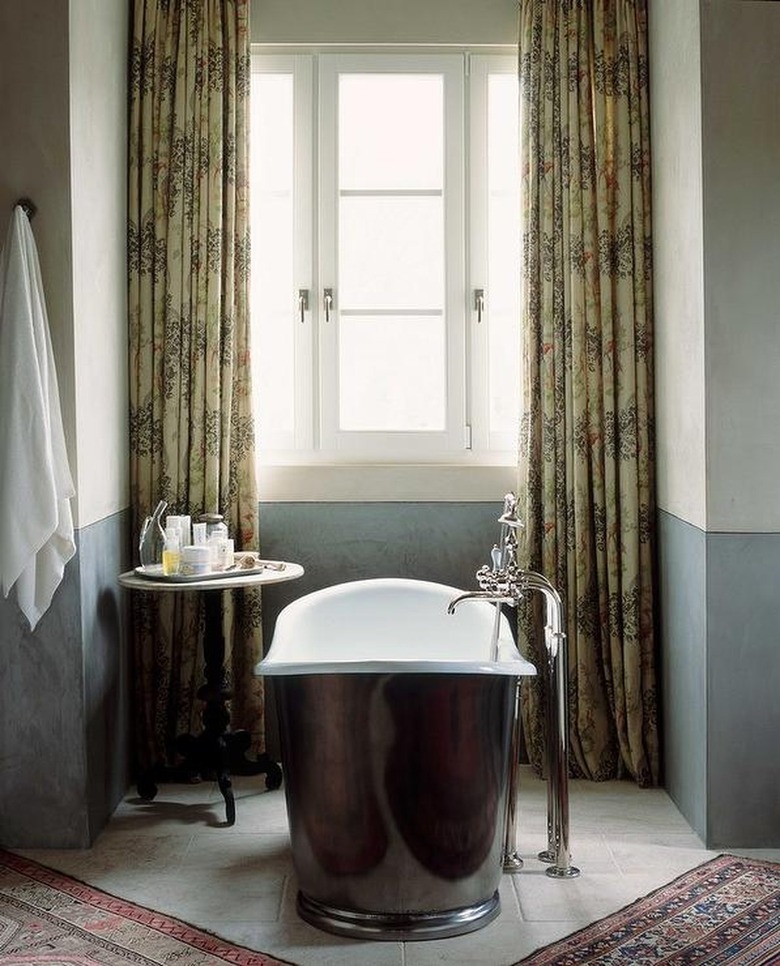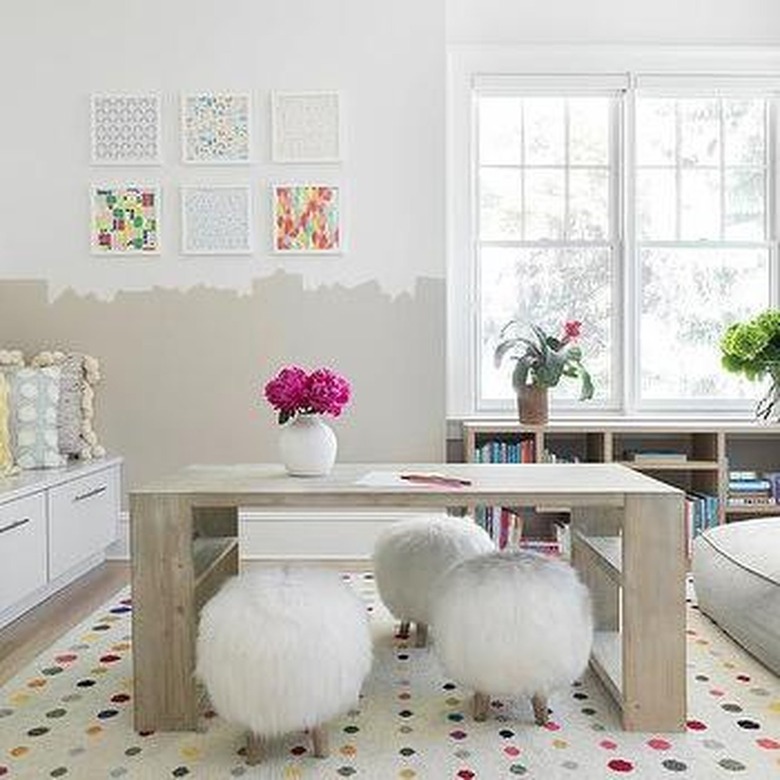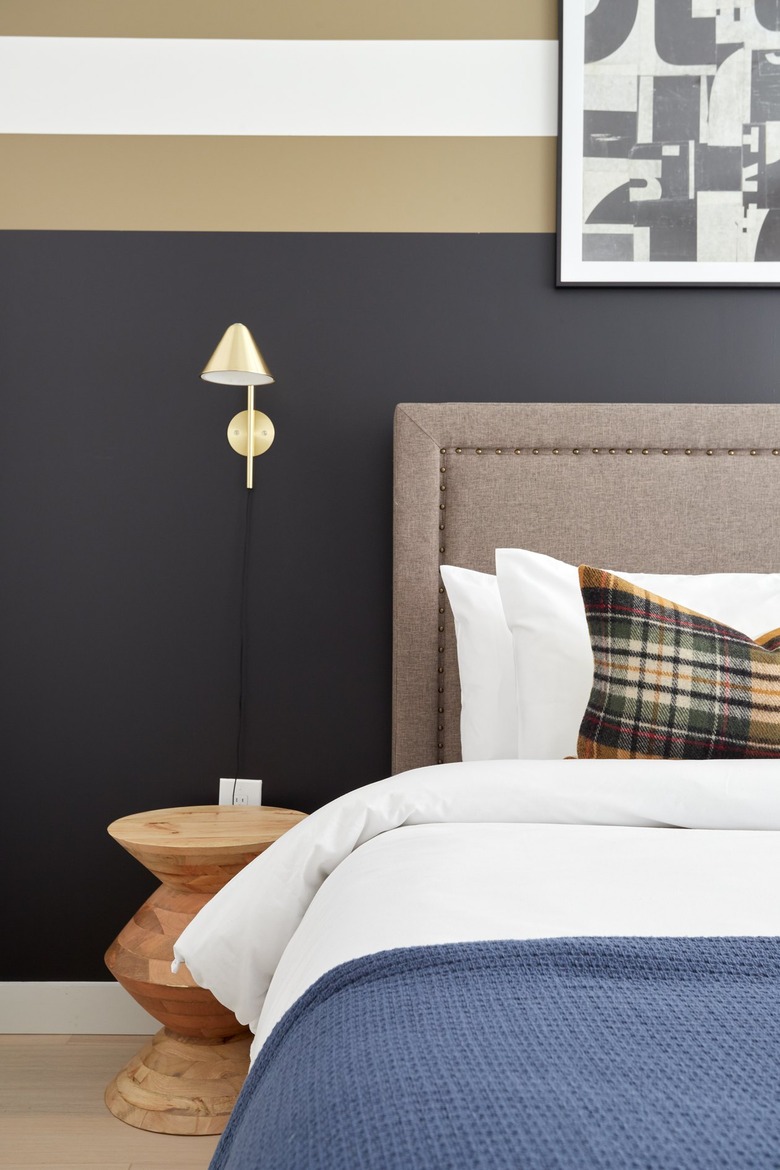10 Steps To Divide A Wall With Two Paint Colors
We may receive a commission on purchases made from links.
If you want to introduce color to your home without the commitment of all-over paint, two-tone walls are a great option. A form of color blocking (the use of blocks of color), two-tone walls are exactly what the name suggests — using two different colors next to one another on a wall. They function in much the same way as an accent wall by imparting a measured dose of color into interior spaces and can do wonders at introducing visual interest and dimension. Historically, two-tone walls were seen in homes with chair rails and wainscoting which offered a natural delineation. These wall treatments would typically be painted white while the area above the woodwork would be painted a different hue.
Today, two-tone walls have gone mainstream and are often created with two paint colors in lieu of decorative molding or paneling. This makes it easy to infuse interest and personality into any room with minimal investment. And the walls don't have to be divided in half either. In fact, many design pros suggest using a color on one-third of the wall and another hue on the remaining two-thirds. You can even continue the color used on the top portion of the wall up to the ceiling for a seamless transition.
"Two-toned walls can be an amazing feature to add to your home to elevate the space and add interest. Not only is it very stylish but it can also be a less expensive alternative to wallcovering," says Emma Kemper, founder and principal designer at Emma Beryl Interiors. "I would color block the bottom half of your walls at the average height of a chair rail and color block the remaining wall space with a contrasting color. One of my favorite combinations to keep the look monochromatic is to [use] a darker shade on the bottom and a lighter shade on top. This application will create a fresh modern look for any space," she continues.
When selecting paint combinations, consider the vibe and energy you're looking to cultivate for that particular space. For example, if you're painting a bedroom, opt for a soothing scheme with blues and greens balanced by a neutral shade to help promote calm and a good night's sleep. Thanks to their youthful vibe and playful nature, children's rooms are the ideal spot for testing out a coupling of vibrant, cheery shades. No matter what space you're looking to refresh, a color wheel is a useful tool for putting together no-fail color schemes. You can't go wrong with complementary hues located across from each other or analogous colors that are found next to one another on the color wheel. Whatever shades you select, just make sure they have the same finish.
"Two-tone walls are great for youthful bedrooms and playrooms where you may want to introduce a pop of color while still maintaining a bright, clean feeling. I usually paint a bolder color on the lower 1/3 or 2/3 which does wonders at hiding fingerprints, smudges, and accidental crayon marks. This unexpected dose of color also serves as a fun background for stickers and artwork," says Beatriz Rose, principal and lead designer at byrdesign.
10 Steps to Divide a Wall With Different Paint Colors
10 Steps to Divide a Wall With Different Paint Colors
If you're a DIY enthusiast, or you are looking to develop your crafty side, painting a two-tone wall is an at-home project that can easily be tackled. Dividing a wall with two shades of paint is an affordable way to add personality and a graphic element without clutter. Depending on where one color ends and another one begins, this technique can create the illusion of more space, make ceilings appear higher or lower, and help create the feeling of intimacy in lofty spaces. Paint is also an effective tool for defining different areas in an open-concept space.
Ready to get started? Ahead you'll find a list of supplies that you'll need as well as step-by-step instructions from Hunker contributor Trisha Sprouse.
Things Needed
Step 1: Pick your colors.
Use peel-and-stick paint samples, which are simple to apply and remove, to decide which colors look best in the space. Place them on several walls to see how they look in changing light.
Step 2: Prep the walls.
Before you get down to painting, clean any dust or cobwebs from the corners of the room. Fill any holes with spackle, and smooth out with a putty knife. Once dry, sand lightly and wipe away any dust.
Step 3: Tape off the decorative trim and the ceiling.
Tape off the trim and ceiling areas with painter's tape. Press firmly to ensure the paint does not seep under the tape. Lay a drop cloth down to protect floors and furniture.
Step 4: Mark where the colors will meet.
Use a tape measure to decide where the two paint colors will meet on the wall, and mark the measurement. Use a level to connect the marks and draw a pencil or chalk line that is completely straight.
Step 5: Cut in around the top half of the wall.
Now that you're ready to start painting, stir the paint with a paint stick, then dip an angled brush into the can. Paint along the taped areas to create a border around the top half of the wall. Clean the brush when done.
Step 6: Roll paint onto the top half.
Remove the cap on top of the paint can by turning it counter-clockwise, and attach the pour spout by turning it clockwise. Pour the paint into the paint tray.
Dip the roller into the paint, and roll it over the tray to remove any excess. Roll the paint onto the walls in a "W" motion to ensure even distribution — bringing the paint slightly below the line you drew. Wait for one to two hours, and apply a second coat once dry. Remove the tape while the paint is still wet.
Step 7: Tape off the bottom half of the wall.
Just as in step five, use a tape measure to mark where the colors will meet on the wall again, and mark the distance at regular intervals. Use a two-foot level to connect the marks with a pencil.
Step 8: Cut in around the bottom half of the wall.
Open the second paint color, and stir it up with a paint stick. Dip a clean angled brush into the paint, and paint along the taped areas on the bottom half of the wall.
Step 9: Roll paint onto the bottom half.
Pour the second color into a clean liner tray, dip the roller into the paint, and roll the paint onto the bottom half of the walls in a "W" motion. Just like the top half, wait for one to two hours, and then re-coat when dry.
Step 10: The big reveal.
While the paint is still wet, remove the tape around the trim and along the line dividing the two colors. And voilà.
10 Creative Two-Tone Wall Ideas
1. Play with different shades from the same color family.
Add a graphic component to traditional spaces with a pair of vibrant colors. Jennifer from City Farmhouse added an eye-catching modern moment to her home's playroom with a duo of deep shades of blue. Bringing color on the lower portion two-thirds up the wall carries the eye upward, creating an elongating effect.
Get the look: Benjamin Moore Clearest Ocean Blue and Benjamin Moore Bold Blue
2. Take the darker color three-quarters of the way up the walls.
Underscore the color of your bed linens with a two-tone wall that coordinates with them. Blush pink takes center stage in this bedroom spotted on British Paints as both the predominant bedding hue and a focal point on the walls. Pairing the rosy shade with crisp white walls makes the room look airy and soft without being overly saccharine. A woven pendant light adds warmth and texture.
Get the look: British Paints Pink Bliss and British Paints Love Note
3. Opt to showcase the darker color on the lower quarter of the walls only.
Strategically placed two-tone paint can function as a stand-in for furniture. In this dining room by Bespoke Only, a band of chalky black paint rendered on the wall horizontally pulls double duty — adding visual weight to a neutral space and giving the appearance of the back of seating without taking up precious real estate. A trio of black sconces ground the room from above.
Get the look: Magnolia Paint Arches and Benjamin Moore Chantilly Lace
4. Allow the doors and trim to get in on the fun.
Don't let the placement of doors, windows, or molding interrupt the flow of the wall design. Extending color onto architectural features (rather than painting around them) infuses a distinct sense of style with a quirky and enviable perspective. This timeless kitchen from @thehouseondolphistreet combines farmhouse elements like marble countertops, an apron sink, and nickel hardware with cleverly painted two-tone walls in classic shades of navy and mint green.
Get the look: Farrow & Ball Hague Blue and Farrow & Ball Teresa's Garden
5. Get creative with wall paneling.
No need to forgo wall treatment entirely in favor of paint. This cabin-inspired bedroom makeover by Raili CA Design makes the most of both ideas, combining board and batten paneling in its natural unadorned state with green paint. Blanketing the doors and surrounding molding in the same hue increases their visual impact.
Get the look: Behr Hummingbird Green
6. Introduce interest to a forgotten corner.
Keep a corner from fading away with the addition of thoughtfully selected two-tone paint. Tucking furniture into a corner maximizes square footage, but can leave interiors that feel overlooked or forgotten. Lindsey Brooke embraced half-painted walls in lilac and white in this bohemian-inspired little girl's room which anchors a white Jenny Lind bed and echos a combination of pastel accessories.
Get the look: Farrow & Ball Sugared Almond and Farrow & Ball All White
7. Go vertical.
Turn two-tone paint ideas on their side by applying color to walls vertically. Make the look even more eye-catching by extending paint onto the ceiling for a modern look that also adds the illusion of height. Raili CA Design opted for alternating swaths of white and sky blue in this little boy's room and amped up the color and whimsy with neatly hung swimming fins.
Get the look: Benjamin Moore Decorator's White and Sherwin-Williams Sky Fall
8. Embrace two muted shades.
For a decidedly Scandi vibe, create a two-tone wall using muted shades. This ski chalet-inspired mud room by Bunsa Studio nailed the look by pairing barely-there gray and creamy white. Weathered leather pieces like a bench, stool, or chair can do wonders at warming up rooms void of color while a pair of vintage skis and snow shoes impart character and personality.
Get the look: Sherwin-Williams Repose Gray and Behr Whisper White
9. Add texture with limewash.
No need to relegate two-tone walls to standard drywall. In fact, limewash, tadelakt, and Roman clay finishes enhance the texture and one-of-a-kind appearance. Wendi Young opted for limewash walls in this intimate bathroom, painting the lower portion a calming blue-gray and the top beige. A freestanding metallic tub and floor-to-ceiling drapery enhance the old-world charm and sophistication of this spot.
Get the look: Portola Paints Reservoir and Portola Paints Leisure
10. Skip the straight dividing line.
Let your creativity flow when deciding where one color ends and another begins. Channel your inner artist when applying two-tone walls with an interesting edge in lieu of a straight line that divides the hues. This refined playroom by JK Interior Living features taupe and white hues with a ragged edge for a pleasing imperfect effect, but this could also be done with any number of designs including scalloped, pointed, or curved edges.
Get the look: Benjamin Moore Annapolis Gray and Benjamin Moore Super White
A Few Things to Consider
A Few Things to Consider
If you love color but aren't sold on using the same paint floor-to-ceiling, then two-tone walls are a manageable (and affordable) compromise. The creative solution imbues personality, architectural interest, and a graphic component to rooms without being visually overwhelming. The sky's the limit when it comes to two-tone paint ideas — you can balance a bold hue with a neutral color or you can go with a bold combination. The color wheel is a helpful tool to reference if you're looking for guidance on color pairings. And with a bit of planning and prep, painting two-tone walls can even be a manageable DIY project.
